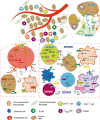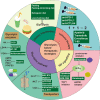Warburg effect in colorectal cancer: the emerging roles in tumor microenvironment and therapeutic implications
- PMID: 36319992
- PMCID: PMC9628128
- DOI: 10.1186/s13045-022-01358-5
Warburg effect in colorectal cancer: the emerging roles in tumor microenvironment and therapeutic implications
Abstract
Colorectal cancer (CRC) is the third most common cancer and the second leading cause of cancer-related death worldwide. Countless CRC patients undergo disease progression. As a hallmark of cancer, Warburg effect promotes cancer metastasis and remodels the tumor microenvironment, including promoting angiogenesis, immune suppression, cancer-associated fibroblasts formation and drug resistance. Targeting Warburg metabolism would be a promising method for the treatment of CRC. In this review, we summarize information about the roles of Warburg effect in tumor microenvironment to elucidate the mechanisms governing Warburg effect in CRC and to identify novel targets for therapy.
Keywords: Colorectal cancer; Metastasis; Therapeutics; Tumor microenvironment; Warburg effect.
© 2022. The Author(s).
Conflict of interest statement
The authors declare that they have no competing interests.
Figures




Similar articles
-
The Colorectal Cancer Microenvironment: Strategies for Studying the Role of Cancer-Associated Fibroblasts.Methods Mol Biol. 2018;1765:87-98. doi: 10.1007/978-1-4939-7765-9_6. Methods Mol Biol. 2018. PMID: 29589303 Free PMC article.
-
Spatial transcriptomics atlas reveals the crosstalk between cancer-associated fibroblasts and tumor microenvironment components in colorectal cancer.J Transl Med. 2022 Jul 6;20(1):302. doi: 10.1186/s12967-022-03510-8. J Transl Med. 2022. PMID: 35794563 Free PMC article.
-
Interleukin 33/ST2 Axis Components Are Associated to Desmoplasia, a Metastasis-Related Factor in Colorectal Cancer.Front Immunol. 2019 Jun 21;10:1394. doi: 10.3389/fimmu.2019.01394. eCollection 2019. Front Immunol. 2019. PMID: 31281317 Free PMC article.
-
Importance of the Microbiota Inhibitory Mechanism on the Warburg Effect in Colorectal Cancer Cells.J Gastrointest Cancer. 2020 Sep;51(3):738-747. doi: 10.1007/s12029-019-00329-3. J Gastrointest Cancer. 2020. PMID: 31735976 Review.
-
Cytokine- and chemokine-induced inflammatory colorectal tumor microenvironment: Emerging avenue for targeted therapy.Cancer Commun (Lond). 2022 Aug;42(8):689-715. doi: 10.1002/cac2.12295. Epub 2022 Jul 5. Cancer Commun (Lond). 2022. PMID: 35791509 Free PMC article. Review.
Cited by
-
Anti-angiogenesis in colorectal cancer therapy.Cancer Sci. 2024 Mar;115(3):734-751. doi: 10.1111/cas.16063. Epub 2024 Jan 17. Cancer Sci. 2024. PMID: 38233340 Free PMC article. Review.
-
The role of dysregulated metabolism and associated genes in gastric cancer initiation and development.Transl Cancer Res. 2024 Jul 31;13(7):3854-3868. doi: 10.21037/tcr-23-2244. Epub 2024 Jul 22. Transl Cancer Res. 2024. PMID: 39145068 Free PMC article. Review.
-
Biochemical hallmarks-targeting antineoplastic nanotherapeutics.Bioact Mater. 2024 Jul 2;36:427-454. doi: 10.1016/j.bioactmat.2024.05.042. eCollection 2024 Jun. Bioact Mater. 2024. PMID: 39044728 Free PMC article. Review.
-
Research progress on the GRP78 gene in the diagnosis, treatment and immunity of cervical cancer.Eur J Med Res. 2023 Oct 20;28(1):447. doi: 10.1186/s40001-023-01241-0. Eur J Med Res. 2023. PMID: 37858217 Free PMC article. Review.
-
The Warburg effect: a score for many instruments in the concert of cancer and cancer niche cells.Pharmacol Rep. 2023 Aug;75(4):876-890. doi: 10.1007/s43440-023-00504-1. Epub 2023 Jun 19. Pharmacol Rep. 2023. PMID: 37332080 Free PMC article. Review.
References
Publication types
MeSH terms
Grants and funding
LinkOut - more resources
Full Text Sources
Medical
Research Materials

